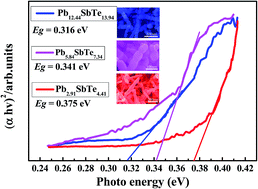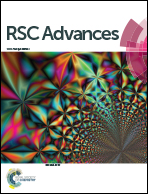Self-sacrifice Te template synthesis of new phase PbmSb2nTem+3n nanorods via Pb2+/Sb3+ synergistic effect†
Abstract
Nanocrystals have been attracted extra attention due to their unique characteristics, different from their bulk counterparts. Herein, we first synthesized the new stable phase of ternary PbmSb2nTem+3n one-dimensional (1D) nanorods with a rough surface, using Te as sacrificial template. X-Ray diffraction techniques (XRD), field emission scanning electron microscopy (FE-SEM) and energy-dispersive spectroscopy (EDS), X-ray photoelectron spectroscopy (XPS) analysis have been used to characterize and determine the structure and composition of the product. By carefully adjusting the experimental conditions, it was found that reaction factors including distinct solvent, the amount of alkali, reaction temperature, the ratio of reactants and growth time, play critical roles in the crystallization process of PbmSb2nTem+3n nanorods. Thorough morphological characterization revealed that significant variation of the morphology of the products originated from varying the amount of Pb/Sb precursors injected. Reaction with excess Pb produces PbmSb2nTem+3n nanocubes with size variations, whereas the initial morphology of the Te nanorod template with a rough surface was preserved in the presence of Sb. The Pb2+/Sb3+ synergistic effect was attributed to the difference of their reaction reactivity. A mechanistic model is proposed to account for these experimental findings. Furthermore, the optical band gaps (Eg) of PbmSb2nTem+3n were investigated as well.


 Please wait while we load your content...
Please wait while we load your content...